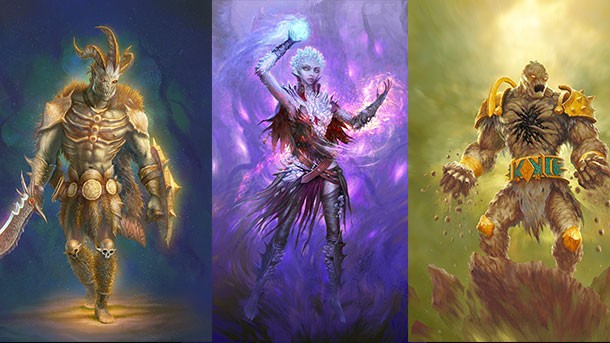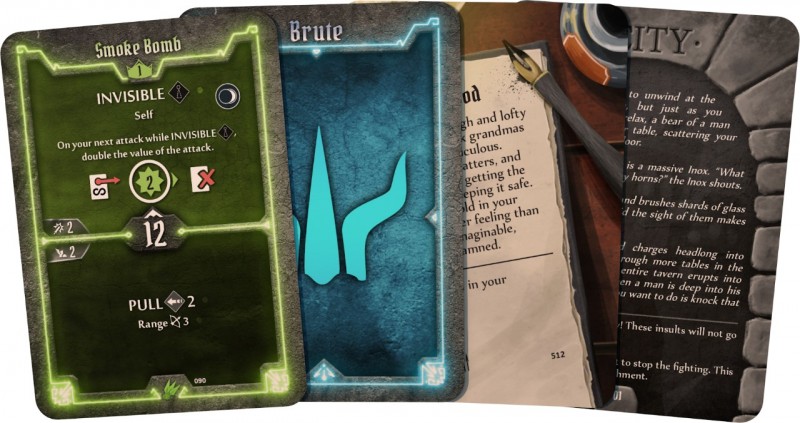Our extra-large special edition is here. Subscribe today and receive the 25% longer issue at no extra cost!
Top Of The Table – Gloomhaven

2017 has been a great year for board games, with tons of innovative designs and intriguing themes to discover on your table. But few games garnered the kind of intense and constant conversation among hardcore hobbyists engendered by Gloomhaven. A centerpiece game for any dedicated player’s collection, Gloomhaven is a sprawling cooperative dungeon crawler in a richly imagined and gritty fantasy world, playable across an interconnected campaign that takes many dozens of hours to complete. Mixing the story-driven fantasy focus, miniatures, and progression-oriented play first popularized by North American RPGs with the minimization of luck players have come to expect from Euro-style games, Gloomhaven is a complex beast of a project. But it’s also one of the most inventive and rewarding board games in a long time…if you’re willing to commit the significant time and energy it takes to uncover its bountiful charms.
You are a mercenary fantasy adventurer out on the edge of the world, exploring the city of Gloomhaven and its wild environs. Brought together by necessity, you must work with your fellow adventurers to survive the area’s many threats, build a fortune, and explore the area. Ultimately, your real goals are personal to your character, and tied into the loop of character progression. The bulk of gameplay is encompassed by tactical hex grid-based combat through a vast array of ancient crypts and ruins, represented on a modular tile-based board. In between adventures, the world map changes, Gloomhaven grows and changes, and players make choices that affect both their own fate and that of the town. New playable heroes emerge over time. The story branches and twists, and your version of the campaign might even include entirely different scenarios and sidequests from another copy of the game, all thanks to your decisions.

Scenarios are played on a modular board that must be set up with various components ahead of play
That’s the promise of fun waiting for you as you stare down for the first time at the imposing box that contains the game. Gloomhaven arrives in a beefy (but gloriously visualized) box that weighs in at a little over 20 pounds. Beneath the rulebook and scenario book are the hundreds of cards, tiles, miniatures, enemy standees, hidden boxes and envelopes (to be opened later in the campaign), and other components that will carry you through the campaign. Everything is high in quality, from the mini sculpts to the evocative art that depicts your heroes, and on through the sturdy cardboard tiles and the premium cards. The huge amount of “stuff” packed into the game is exciting, but even veteran gamers may balk at the sheer bulk of everything at hand, and trying to find a way to organize it all is a big challenge. That dilemma extends to the setup and pulldown of the game, which takes a long time.
For a game that has so many components to juggle, and such a complex setup for every session, I’m happy to say that the game design itself tends toward elegance, sensible and easy-to-learn iconography, and comparatively manageable turn speeds. I don’t mean to imply that the game is simple; Gloomhaven is a weighty affair of interlocking rules and systems, and it takes a good while to learn. However, everything fits together the way it should, and once players understood those systems, I rarely encountered concepts that weren’t solid and thoughtfully explained by the rules. Mechanics like line-of-sight, initiative, and even managing enemy A.I. are all relatively straightforward and clear.

The campaign map board gains new stickers over the life of the game and as you discover new locations
With the first scenario laid out and the dungeon beckoning you forward, the real star of Gloomhaven makes itself apparent – combat. As you march into darkness and the many villainous beasties hidden within, battles unfold through a card-based system of movement and actions that puts tremendous control in the hands of the players. Players wield a hand of cards, each of which features a top and bottom action. On your turn, you play two of those cards, and complete the top action from one and the bottom action from the other (often corresponding to some variation of movement and attack). Attacks are modified by a blind draw from another card deck that might affect the outcome, lending a touch of random chance. However, the system is entirely diceless, and gives the player tremendous agency to shape their own strategy. The array of powers and other actions is significant, and does a phenomenal job of helping individual character classes feel distinct and relevant.
Actions diminish your hand of cards over time, forcing you to eventually use precious time to rest, or else become worn out, necessitating a retreat from the dungeon and the likely need to replay the scenario. I adore this abstraction of slow exhaustion from the mental and physical rigors of the adventure. It lends thematic power to the dark dungeon delve, but it also leads to tension and immediacy around every action you take. There’s no room for dallying about in these dangerous locales; every action demands that you push forward and defeat your foes. Equally important, the cards themselves are a fascinating puzzle to consider, as you mix and match different abilities, attempt to set up powerful combos, and take big chances on plays that put your character at risk through expending precious cards, but might just save the party and complete the scenario. Gloomhaven’s most thrilling moments arise in these instances, as players pull a clutch attack at just the right moment.
[Next Page: An ongoing campaign of new playable characters, a changing map, and customized narrative]

The starting character classes are all especially cool and surprising, as are later secret unlockable heroes
The combat encounters really are the bulk of the game, but Gloomhaven is also a legacy game, in which the story is ongoing between sessions, and new components, characters, and story elements alter the game over time. Many of these changes occur between major dungeon scenarios, depicted through events that unfold in town or on the road, where choices shape both the world, and the way the world perceives your party of adventurers. Random side missions are sometimes drawn, adding a new location sticker to the map, which might be the site of an entirely new optional adventure. New items go on sale in town. Achievement stickers begin to get added to the map board, sometimes changing significant features of the world, like the style of government that currently controls the city.
The game even includes a way to have multiple player groups running simultaneously in the same game world, progressing their own parties through explorations and scenarios. Like the best legacy games, many cool features remain hidden during your early hours of play, and only certain choices lead to you opening the box or envelope you’re curious about. And your characters are constantly acquiring new cards and stickers that change and evolve their abilities. Six starting character classes as well as subsequent unlocked playable adventurers riff brilliantly on familiar fantasy tropes, layering in fascinating races, story backgrounds, and unique powers.
Cephalofair has crafted an incredibly ambitious project in Gloomhaven, and one that I expect will serve as inspiration to many subsequent designs in the coming years. But it’s also a game crafted from the ground up to speak to devoted hobby gamers with a lot of time and energy to devote to a single project. If you’re the sort of player who prefers one or two sessions of a game before moving on to the next, the pure complexity, size, and cost of Gloomhaven is likely prohibitive. For those looking for that kind of investment, it’s hard to imagine a more rewarding board game adventure to attempt. That depth of reward is enhanced by the deep replayability. Not only can multiple separate groups of two to four players at a time enjoy a single copy, but the game also ably supports solo play (by controlling two characters), letting an enthusiastic owner explore Gloomhaven’s depths even when friends can’t show up to play. Whether played alone or with your longtime gaming group, Gloomhaven is a potent showpiece for the current depth, artistic sophistication, and design complexity that are on offer in the current hobby scene.

An array of cards dictates the flow of action, including ability cards that provide choices about what to do on each turn
Gloomhaven can be a tricky game to track down these days, but don’t worry if you can’t find a copy at your favorite local or online game store. Designer Isaac Childres tells me that the second printing of the game is set to hit retail in mid-January, in just a few weeks.
In the meantime, if you’re doing some holiday shopping, now is the perfect time to peruse the backlog of recommendations in our Top of the Table hub, which can be reached by clicking on the banner at the bottom of this article. You can expect to find a ton of great tabletop games that would please any board game enthusiast in your family. If you’re struggling with what to purchase, hit me up via email or Twitter, and I’ll try to offer some last-minute recommendations tailored to the gamer in your family.
Make sure and swing back in two weeks, when this column will highlight the best tabletop games released in 2017. That article will include dedicated selections from across the breadth of board, card, and miniature releases, as well as a dedicated section on the best tabletop role-playing projects from the last year.


Get the Game Informer Print Edition!
Explore your favorite games in premium print format, delivered to your door.
- 10 issues per year
- Only $4.80 per issue
- Full digital magazine archive access
- Since 1991








